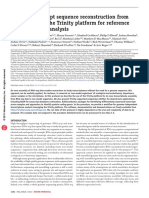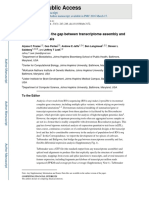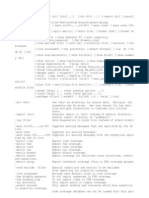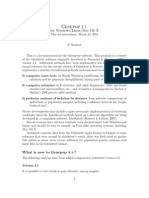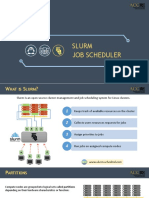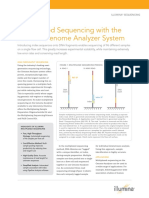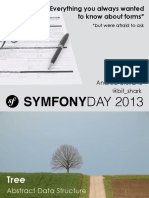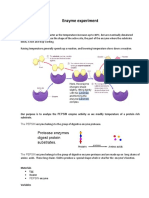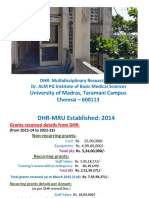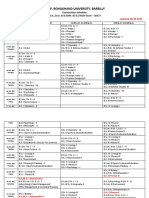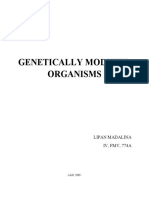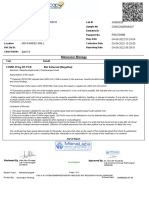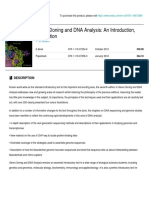Version 3.0.2 July 2017: BUSCO: Assessing Genome Assembly and Annotation Completeness With Single-Copy Orthologs
Uploaded by
cquintoVersion 3.0.2 July 2017: BUSCO: Assessing Genome Assembly and Annotation Completeness With Single-Copy Orthologs
Uploaded by
cquintohttp://busco.ezlab.
org
Version 3.0.2; July 2017
This document was last updated: 14 July 2017
BUSCO: assessing genome assembly and annotation completeness with single-copy orthologs
Felipe A. Simão, Robert M. Waterhouse, Panagiotis Ioannidis,
Evgenia V. Kriventseva, & Evgeny M. Zdobnov
with BUSCO v3 contributions from Mathieu Seppey, Mosè Manni, & Fredrik Tegenfeldt
Bioinformatics (2015) 31 (19): 3210-3212
Abstract DOI: 10.1093/bioinformatics/btv351 PMID: 26059717
First published online: June 9, 2015. Article Metrics
Citations: Google Scholar, PubMed
Zdobnov’s Computational Evolutionary Genomics Group: http://cegg.unige.ch
Department of Genetic Medicine and Development, University of Geneva Medical School
and Swiss Institute of Bioinformatics, rue Michel-Servet 1, 1211 Geneva, Switzerland.
Please send questions (after reading this user guide) to: support@orthodb.org
Copyright © 2017 University of Geneva Medical School / Swiss Institute of Bioinformatics.
Permission is granted to make and distribute verbatim copies of this manual provided the copyright notice
and this permission notice are retained on all copies.
BUSCO is licensed and freely distributed under the MIT License.
For a copy of the license, see https://gitlab.com/ezlab/busco/raw/master/LICENSE
Contents
Introduction.................................................................................................................................. 3
Software setup............................................................................................................................. 4
Installation................................................................................................................................ 4
Virtual machine............................................................................................................................ 6
Quick start BUSCO assessments................................................................................................ 7
1- Genome assembly assessment........................................................................................... 7
2- Gene set (proteins) assessment...........................................................................................7
3- Transcriptome assessment.................................................................................................. 7
Options........................................................................................................................................ 8
1- Mandatory arguments.......................................................................................................... 8
2- Optional arguments.............................................................................................................. 9
Output........................................................................................................................................ 10
1- Main results files................................................................................................................ 10
2- Results directories.............................................................................................................. 10
Test with sample data................................................................................................................. 11
Assessment sets........................................................................................................................ 13
1- BUSCO selections............................................................................................................. 13
2- BUSCO lineages................................................................................................................ 14
Plotting results........................................................................................................................... 16
Backward compatibility.............................................................................................................. 17
Interpreting BUSCO results........................................................................................................ 18
Best practices............................................................................................................................ 19
Troubleshooting......................................................................................................................... 20
Release notes............................................................................................................................ 20
Acknowledgements.................................................................................................................... 21
BUSCO v3.0.2 User Guide: Page 2
Introduction
BUSCO completeness assessments employ sets of Benchmarking Universal Single-Copy
Orthologs from OrthoDB (www.orthodb.org) to provide quantitative measures of the
completeness of genome assemblies, annotated gene sets, and transcriptomes in terms of
expected gene content. Genes that make up the BUSCO sets for each major lineage are
selected from orthologous groups with genes present as single-copy orthologs in at least 90% of
the species. While allowing for rare gene duplications or losses, this establishes an
evolutionarily-informed expectation that these genes should be found as single-copy orthologs
in any newly-sequenced genome. The evolutionary expectation means that if the BUSCOs
cannot be identified in a genome assembly or annotated gene set, it is possible that the
sequencing and/or assembly and/or annotation approaches have failed to capture the complete
expected gene content.
An evolutionary expectation of gene content.
Classifying orthologs according to their universality (from widespread to specific or sparse
species presence) and their duplicability (from mostly
multi-copy to mostly single-copy) reveals an orthology
landscape. BUSCOs are selected from orthologous
groups with single-copy orthologs in the majority of
species (circled in red). Thus, BUSCO searches are
expected to find matching single-copy orthologs in any
newly-sequenced genome from the appropriate species
c l a d e . F i g u r e a d a p t e d f r o m t h e Drosophila
melanogaster i n s e c t o r t h o l o g y l a n d s c a p e i n
Waterhouse, Current Opinion in Insect Science, 2015.
BUSCO sets were first defined using orthologs from
OrthoDB v7 as described in Waterhouse et al. Nucleic
Acids Research, 2013, PMID: 23180791, and were
subsequently incorporated into the BUSCO assessment tool as described in Simão et al.
Bioinformatics, 2015, PMID: 26059717. BUSCO v2 implemented improvements to the
underlying analysis software as well as updated and extended sets of BUSCOs covering
additional lineages based on orthologs from OrthoDB v9 (Zdobnov et al. Nucleic Acids
Research, 2017, PMID: 27899580). BUSCO v3 maintains all v2 features and uses the same
lineage datasets. It is the result of a major refactoring of the codebase, converting the original
single BUSCO script into a python package available system-wide, v3 now also makes use of a
user-editable configuration file in addition to the standard command line arguments. The
assessment tool implements a computational pipeline to identify and classify BUSCO group
matches from genome assemblies, annotated gene sets, or transcriptomes, using HMMER
hidden Markov models and de novo gene prediction with Augustus. Running the assessment
tool requires working installations of Python, HMMER, Blast+, and Augustus (genome
assessment only). Genome assembly assessment first identifies candidate regions to be
assessed with tBLASTn searches using BUSCO consensus sequences. Gene structures are
then predicted using Augustus with BUSCO block profiles. These predicted genes, or all genes
from an annotated gene set or transcriptome, are then assessed using HMMER and lineage-
specific BUSCO profiles to classify matches. The recovered matches are classified as
‘complete’ if their lengths are within the expectation of the BUSCO profile match lengths. If these
are found more than once they are classified as ‘duplicated’. The matches that are only partially
recovered are classified as ‘fragmented’, and BUSCO groups for which there are no matches
that pass the tests of orthology are classified as ‘missing’.
BUSCO v3.0.2 User Guide: Page 3
Software setup
Installation
[0] BUSCO has been developed and tested on Linux (e.g. Arch Linux, CentOS, Ubuntu) and
can be run on MacOS X, provided you are able to install Augustus properly, as issues have
been reported. We recommend using a Linux box for running BUSCO with its installed
dependencies, and cannot provide support for MacOS and Windows operating systems. As an
alternative to setting up BUSCO on your own machine, you can use the BUSCO virtual machine
(see next section for details).
[1] The BUSCO assessment software distribution is available from the public GitLab project:
https://gitlab.com/ezlab/busco where it can be downloaded or cloned using a git client (git clone
https://gitlab.com/ezlab/busco.git). We encourage users to opt for the git client option in order to
facilitate future updates.
[2] BUSCO is written for Python 3.x and Python 2.7+. It runs with the standard packages. We
recommend using Python3 when available.
[3] BUSCO v3 requires its packages to be installed on the system by running setup.py on the
version of python chosen to run the tool. You can run it with root privileges or for the current
user only by choosing one of these two possibilities:
sudo python setup.py install
python setup.py install --user
Note: You need the BUSCO main folder to be your current directory when running setup.py.
[4] BUSCO v3 employs a user-editable configuration file for defining required settings and
parameters (previously set through the command line arguments). In the config/ subfolder
the config.ini.default file must first be copied to config.ini and then edited before
running BUSCO. In this file, you must declare the paths to all dependencies (see below) and
you can optionally define the required input parameters (described later in this document). Note:
providing input parameters through the command line will override those defined in
config.ini. The config.ini.default file is extensively commented and self explanatory.
Additionally, you can define a custom path (including the filename) to the config.ini file by
setting the following environment variable, which will override the default location:
export BUSCO_CONFIG_FILE="/path/to/filename.ini"
This is useful for switching between configurations or in a multi-users environment.
BUSCO v3.0.2 User Guide: Page 4
[ 5 ] In addition to Python, you will need to make sure that the following required software
packages are installed with their paths declared in the config.ini file.
NCBI BLAST+ [NB: please see release note 2.0.1 below]
https://ftp.ncbi.nlm.nih.gov/blast/executables/blast+/LATEST
HMMER (HMMER v3.1b2)
http://hmmer.org/
Augustus (> 3.2.1) (only used for assessing genomes)
http://bioinf.uni-greifswald.de/augustus/
Augustus uses several executables and PERL scripts. Please refer to Augustus
documentation for PERL requirements.
In addition to the entries in the config.ini file, Augustus requires environment
variables to be declared as follows:
export PATH="/path/to/AUGUSTUS/augustus-3.2.3/bin:$PATH"
export PATH="/path/to/AUGUSTUS/augustus-3.2.3/scripts:$PATH"
export AUGUSTUS_CONFIG_PATH="/path/to/AUGUSTUS/augustus-3.2.3/config/"
NB: you can use the printenv command to view all your environment settings.
Please make sure that each of the three software packages listed above work
INDEPENDENTLY of BUSCO before attempting to run any BUSCO assessments.
How to solve: ‘ERROR Cannot write to Augustus config path …’
If Augustus is installed globally on your system and you do not have administrator rights there is
a simple workaround that should work on most systems. This is because during genome mode
assessments Augustus needs to write gene model prediction parameters to its own ‘config’
directory, and if you do not have write access to this directory the analysis will fail. Simply
recursively copy the entire Augustus ‘config’ directory to a location where you do have write
access, and then set the AUGUSTUS_CONFIG_PATH variable to this location.
cp -r /path/to/AUGUSTUS/augustus-3.2.3/config /my/home/augustus/config
export AUGUSTUS_CONFIG_PATH="/my/home/augustus/config/"
[6] Depending on the species you wish to assess, you should now download the appropriate
lineage-specific profile libraries and accompanying information from http://busco.ezlab.org to
your BUSCO directory: for example, actinopterygii_odb9, arthropoda_odb9, ascomycetes_odb9,
aves_odb9, bacteria_odb9, diptera_odb9, endopterygota_odb9, eukaryota_odb9, fungi_odb9,
hymenoptera_odb9, insecta_odb9, mammalia_odb9, metazoa_odb9, or vertebrata_odb9.
BUSCO v3.0.2 User Guide: Page 5
Virtual machine
The BUSCO assessment tool and its dependencies (e.g. BLAST, HMMER, Augustus) have
been set up on a virtual machine (VM) that can be downloaded from http://busco.ezlab.org/. The
Ubuntu GNOME 32-bit BUSCO VM was built using OSboxes (http://www.osboxes.org/) and
can be launched with VM software such as VMware (https://www.vmware.com/) or VirtualBox
(https://www.virtualbox.org/), so you will need to download and install the most appropriate
version (e.g. for Windows, Linux, Macintosh, or Solaris etc.) of the VM software for your system.
Please note: we cannot provide support for setting up the VM software, please refer to their
websites for the required setup information, and how to use them to launch a VM, especially if
you want to configure it to be able to use multiple processors.
Once you have launched the BUSCO VM then you can run BUSCO as you would normally, e.g.
by first creating a new working directory for a new project and arranging your input files
accordingly. Simply right click and open a terminal, this will start you off in the
~/BUSCOVM/busco3 directory. Double click the ‘Link to BUSCOVM’ icon to open the VM’s
directory explorer (contents detailed below). You will also need to download (from
http://busco.ezlab.org/) and unpack the tarball of the lineage(s) that you intend to use: e.g. in the
lineages directory, tar –xf vertebrata_odb9.tar.gz
The VM directories:
augustus Contains Augustus software
busco3 Contains BUSCO software
hmmer Contains HMMER software
lineages Directory for BUSCO lineage datasets (download and unpack tarballs before
use!)
Example:
From the ~/BUSCOVM/busco3 directory in the terminal, create a new working directory:
mkdir MyProject1
From that directory, get your assembly, transcriptome, or gene set that you wish to assess:
wget website/where_your/data_are_found/YOUR_SEQUENCE_FILE.fa
Then launch a BUSCO assessment of your data, e.g.
python ~/BUSCOVM/busco3/scripts/run_BUSCO.py
-i YOUR_SEQUENCE_FILE.fa -o OUTPUT_NAME
-l ~/BUSCOVM/lineages/NAME_OF_LINEAGE -m geno
BUSCO v3.0.2 User Guide: Page 6
Quick start BUSCO assessments
-m or --mode sets the assessment MODE: genome, proteins, transcriptome
1- Genome assembly assessment
python scripts/run_BUSCO.py -i SEQUENCE_FILE -o OUTPUT_NAME
-l LINEAGE -m geno
SEQUENCE_FILE genome assembly file in FASTA format
OUTPUT_NAME name to use for the run and all temporary files (appended)
LINEAGE location of the BUSCO lineage data to use (e.g. eukaryota_odb9)
(NB: without specifying a particular species, Augustus species
parameters will be selected according to the predefined defaults)
2- Gene set (proteins) assessment
python scripts/run_BUSCO.py -i SEQUENCE_FILE -o OUTPUT_NAME
-l LINEAGE -m prot
SEQUENCE_FILE gene set (protein amino acid sequences) file in FASTA format
OUTPUT_NAME name to use for the run and temporary files (appended)
LINEAGE location of the BUSCO lineage data to use (e.g. vertebrata_odb9)
3- Transcriptome assessment
python scripts/run_BUSCO.py -i SEQUENCE_FILE -o OUTPUT_NAME
-l LINEAGE -m tran
SEQUENCE_FILE transcript set (DNA nucleotide sequences) file in FASTA format
OUTPUT_NAME name to use for the run and temporary files (appended)
LINEAGE location of the BUSCO lineage data to use (e.g. fungi_odb9)
Example assessment runtimes (gene sets with 5 CPUs, genomes with 12 CPUs):
Human genome (3.1 Gbp), assessed with 4’104 mammalian BUSCOs: 6 days 15 hours
Human gene set (20’398 proteins), assessed with 4’104 mammalian BUSCOs: ~20 minutes
Human genome (3.1 Gbp), assessed with 978 metazoan BUSCOs: ~21 hours
Human gene set (20’398 proteins), assessed with 978 metazoan BUSCOs: ~3 minutes
Drosophila genome (140 Mbp), assessed with 2’799 dipteran BUSCOs: ~1 hour 45 minutes
Drosophila gene set (13’954 proteins), assessed with 2’799 dipteran BUSCOs: ~14 minutes
Drosophila genome (140 Mbp), assessed with 978 metazoan BUSCOs: ~19 minutes
Drosophila gene set (13’954 proteins), assessed with 978 metazoan BUSCOs: ~2 minutes
NB: more fragmented genomes will take longer as second round searches and gene predictions
are performed for BUSCOs found to be fragmented or missing after the first round.
BUSCO v3.0.2 User Guide: Page 7
Options
python scripts/run_BUSCO.py -i [SEQUENCE_FILE] -o [OUTPUT_NAME]
-l [LINEAGE] -m [MODE]
Any provided command line argument overrides its equivalent in the config.ini file.
A mandatory argument can only be omitted from the command line if it is defined in the
config.ini file.
1- Mandatory arguments
-i SEQUENCE_FILE, --in SEQUENCE_FILE
Input sequence file in FASTA format (not compressed/zipped!).
Can be an assembled genome or transcriptome (DNA),
or protein sequences from an annotated gene set.
NB: select just one transcript/protein per gene for your input,
otherwise they will appear as ‘Duplicated’ matches.
-o OUTPUT_NAME, --out OUTPUT_NAME
Give your analysis run a recognisable short name.
Output folders and files will be labelled (prepended) with this name.
WARNING: do not provide a path.
-l LINEAGE, --lineage_path LINEAGE
Specify location of the BUSCO lineage data to be used.
Visit http://busco.ezlab.org/ for available lineages.
-m MODE, --mode MODE
Specify which BUSCO analysis mode to run.
There are three valid modes:
- geno or genome, for genome assemblies (DNA).
- tran or transcriptome, for transcriptome assemblies (DNA).
- prot or proteins, for annotated gene sets (protein).
2- Optional arguments
-c N, --cpu N
Specify the number (N=integer) of threads/cores to use (default: 1).
-e N, --evalue N
E-value cutoff for BLAST searches.
Allowed formats: 0.001 or 1e-03 (default: 1e-03).
BUSCO v3.0.2 User Guide: Page 8
-f, --force
Force rewriting of existing files/folders.
Must be used when output files with the provided name already exist.
-sp SPECIES, --species SPECIES
Name of existing Augustus species gene finding parameters.
See Augustus documentation for available options.
Each lineage has a default species (see below on assessment sets).
Selecting a closely-related species usually produces better results.
-t PATH, --tmp PATH
Where to store temporary files (default: ./tmp).
-z, --tarzip
Results folders with many files will be tarzipped.
-r, --restart
Restart the BUSCO run from the last successfully-completed step.
NB: If all the required results files from previous steps are not all found
then this will not be possible.
--limit REGION_LIMIT
How many candidate regions to consider (integer, default: 3).
NB: this limit is on scaffolds, chromosomes, or transcripts, not individual
hit regions.
--long
Turn on Augustus optimization mode for self-training (default: Off).
Adds substantially to the run time!
Can improve results for some non-model organisms.
-q, --quiet
Disable the info logs, display only errors.
--blast_single_core
Force tblastn to run on a single core and ignore the --cpu argument for
this step only. Useful if inconsistencies when using multiple threads are
noticed [NB: please see release note 2.0.1 below]
-v, --version
Show this version information and exit.
-h, –-help
Show this help message and exit.
PASSING SPECIAL AUGUSTUS OPTIONS:
--augustus_options='--option1=value1 --option2=value2'
Allows for the passing of special options to Augustus.
E.g. --augustus_options='--translation_table=6 –progress=true'
BUSCO v3.0.2 User Guide: Page 9
Output
Successful execution of the BUSCO assessment pipeline in any mode will create a directory
named run_OUTPUT_NAME where ‘OUTPUT_NAME’ is your assigned name for the assessment
run (set with the -o OUTPUT_NAME mandatory option). Similarly, individual results files from
your assessment run will also be labelled with your run ‘OUTPUT_NAME’. This output results
directory will contain several files and directories:
Where: OUTPUT_NAME in this example was set to XXXX
1- Main results files
short_summary_XXXX.txt
Contains a plain text summary of the results in BUSCO notation.
Also gives a brief breakdown of the metrics.
full_table_XXXX.tsv
Contains the complete results in a tabular format with scores and lengths of
BUSCO matches, and coordinates (for genome mode) or gene/protein IDs
(for transcriptome or proteins mode).
missing_buscos_list_XXXX.tsv
Contains a list of missing BUSCOs.
2- Results directories
hmmer_output
Tabular format HMMER output of searches with BUSCO HMMs.
translated_proteins
Transcript sequence translations, only created during transcriptome assessment.
blast_output
tBLASTn results, not created for assessment of proteins.
File: tblastn_XXXX.txt = tabular tBLASTn results
File: coordinates_XXXX.txt = locations of BUSCO matches (genome mode)
augustus_output
Augustus-predicted genes, only created during genome assessment.
File: augustus.log = full details on Augustus jobs
File: training_set_XXXX.txt = genes used for Augustus training
Folder: predicted_genes = Augustus raw gene output
Folder: extracted_proteins = Augustus protein FASTA output
Folder: retraining_parameters = Augustus species folder, created during
BUSCO retraining. Specific to your species.
Can be put back in Augustus species folder.
Folder: gb = GenBank format complete BUSCOs
Folder: gffs = General Feature Format complete BUSCOs
single_copy_busco_sequences (genome mode only)
FASTA format file for each complete single-copy BUSCO identified.
.faa files contain protein sequences
.fna files contain coding sequences.
BUSCO v3.0.2 User Guide: Page 10
Test with sample data
Sample data are provided to test your BUSCO setup. Execute the following commands and
compare the final output ‘run_TEST’ with the provided files in ‘sample_data/run_SAMPLE’.
1. Run BUSCO assessment on sequence file ‘target.fa’ in genome mode using the
‘example’ lineage, both found in the ‘sample_data’ folder.
python scripts/run_BUSCO.py --in sample_data/target.fa --out TEST
--lineage_path sample_data/example --mode genome
or
python scripts/run_BUSCO.py -i sample_data/target.fa -o TEST -l
sample_data/example -m geno
2. Compare your final output ‘run_TEST’ with the results provided files in ‘run_SAMPLE’.
Your results should be located in the folder ‘run_TEST’:
Folder: augustus_output
Folder: blast_output
Folder: hmmer_output
Folder: single_copy_busco_sequences
File: full_table_TEST.tsv
File: missing_buscos_list_TEST.tsv
File: short_summary_TEST.txt
BUSCO v3.0.2 User Guide: Page 11
Example output: short_summary_TEST.txt
# BUSCO version is: 3.0.0
# The lineage dataset is: sample dataset BUSCO 2.0 (Creation date:
07.10.2016, number of species: 23, number of BUSCOs: 10)
# To reproduce this run: python scripts/run_BUSCO.py -i
sample_data/target.fa -o TEST -l sample_data/example -m genome -c 1 -f
#
# Summarized benchmarking in BUSCO notation for file
sample_data/target.fa
# BUSCO was run in mode: genome
C:80.0%[S:80.0%,D:0.0%],F:0.0%,M:20.0%,n:10
8 Complete BUSCOs (C)
8 Complete and single-copy BUSCOs (S)
0 Complete and duplicated BUSCOs (D)
0 Fragmented BUSCOs (F)
2 Missing BUSCOs (M)
10 Total BUSCO groups searched
Example output: full_table_SAMPLE.tsv
Columns are: BUSCO ID, status, scaffold name, start, end, score, length
# BUSCO version is: 3.0.0
# The lineage dataset is: sample dataset BUSCO 2.0 (Creation date:
07.10.2016, number of species: 23, number of BUSCOs: 10)
# To reproduce this run: python scripts/run_BUSCO.py -i
sample_data/target.fa -o TEST -l sample_data/example -m genome -c 1 -f
#
BUSCO_1 Complete sample 30184 31421 320.9 193
BUSCO_2 Complete sample 31646 47625 872.0 443
BUSCO_3 Complete sample 62761 68675 241.8 146
BUSCO_4 Complete sample 69310 70561 420.3 418
BUSCO_5 Complete sample 70677 71872 497.8 304
BUSCO_6 Complete sample 81792 89171 1676.7 920
BUSCO_7 Complete sample 168309 169293 423.6 243
BUSCO_8 Complete sample 232880 234117 274.6 194
BUSCO_9 Missing
BUSCO_10 Missing
BUSCO v3.0.2 User Guide: Page 12
Assessment sets
1- BUSCO selections
As described briefly in the introduction, BUSCOs are selected from OrthoDB orthologous groups
at major species radiations requiring orthologues to be present as single-copy genes in the vast
majority (>90%) of species. BUSCO v1 sets were selected from OrthoDB v7, and BUSCO v2
sets were selected from OrthoDB v9. The selection of species for each lineage proceeds via a
three-step process: (i) all orthologous groups with genes present in more than half the species
for the given lineage are first identified for downstream processing (the >50% set); (ii) sets of
closely-related species are then identified using the mean percent identity of all best reciprocal
hits between each pair of species, and a representative for each set is chosen by identifying the
species with the fewest number of missing orthologues in the >50% set of orthologous groups;
(iii) these representatives (or singletons in the case of no close-relatives) are then assessed to
sum the number of orthologous groups for which they contain a single-copy orthologue, multi-
copy orthologues, or they are missing an orthologue. Those with significantly more multi-copy or
missing orthologues are flagged for removal from the species set, but species holding key
phylogenetic positions in the lineage (e.g. outgroup species, or species from subclades with few
representatives) can be retained. Species that are removed (too closely-related or poorly-
performing species) will not be used for building the final BUSCO profiles, but the set of
removed species is still used as a filter as only orthologous groups where these species are
>75% present and >50% single-copy will be retained. This step is iterated with manual
selections at each stage until all species have either been selected to be retained or they do not
have significantly more multi-copy or missing orthologous groups.
Additional filters may be added to ensure that outgroup species or species from subclades with
few representatives are not missing disproportionately high numbers of orthologues. The mean
percent identity used to define closely-related sets of species will vary according to the diversity
of the set being assessed, the aim being to ensure that the species selection is not dominated
by species from a few subclades. Selecting species to be retained (despite having significantly
more multi-copy or missing orthologues) is a subjective process, guided by the species
phylogeny and the resulting numbers of BUSCOs obtained.
These initial sets of BUSCOs are then used to build their corresponding BUSCO profiles. Those
with low-quality protein sequence alignments, or that fail to produce BUSCO block profiles for
use by Augustus are discarded. The remaining BUSCOs are then assessed for their accuracy at
correctly recalling the orthologues that were used to build their BUSCO profiles (i.e. running
BUSCO in protein mode on the full gene sets of the selected input species) and poorly-
performing ones are discarded. Finally, a selection of genome assembly assessments are
carried out and BUSCOs that consistently fail to recover complete gene predictions, despite
these genes being present in the genome assemblies, are also discarded.
BUSCO v3.0.2 User Guide: Page 13
2- BUSCO lineages
The tables below provide detailed information on the numbers of species and orthologous
groups selected for each BUSCO v2 lineage, and their default species for genome mode
assessments (i.e. if the user does not specify a species from the parameter sets precomputed
by Augustus).
For further information about the species sets, the orthologous groups, and their member
genes/proteins, view the detailed information provided with each lineage download.
Each lineage dataset should contain:
Folder: hmms HMM file for each BUSCO
Folder: info Files with lists of species, genes, ortho-groups, and annotations
Folder: prfl Block profile file for each BUSCO
File: ancestral FASTA file, consensus ancestral sequences for each BUSCO
File: ancestral_variants FASTA file, consensus & variant sequences for each BUSCO
File: dataset.cfg Configuration data including default Augustus species
File: lengths_cutoff Length cut-offs for complete BUSCO matches
File: scores_cutoff Score cut-offs for orthologous BUSCO matches
Bacterial lineages:
Number of Augustus
Number of
Lineage BUSCO default species
species
groups parameters
bacteria_odb9 3663 148 E_coli_K12
proteobacteria_odb9 1520 221 E_coli_K12
gammaproteobacteria_odb9 721 452 E_coli_K12
enterobacteriales_odb9 216 781 E_coli_K12
deltaepsilonsub_odb9 218 296 E_coli_K12
betaproteobacteria_odb9 215 582 E_coli_K12
rhizobiales_odb9 154 686 E_coli_K12
firmicutes_odb9 951 232 E_coli_K12
lactobacillales_odb9 330 443 E_coli_K12
clostridia_odb9 289 254 E_coli_K12
bacillales_odb9 238 526 s_aureus
actinobacteria_odb9 412 352 E_coli_K12
bacteroidetes_odb9 264 443 E_coli_K12
cyanobacteria_odb9 112 834 E_coli_K12
spirochaetes_odb9 102 237 E_coli_K12
tenericutes_odb9 68 166 E_coli_K12
BUSCO v3.0.2 User Guide: Page 14
Eukaryotic lineages:
Number of Number of Augustus
Lineage species BUSCO default species
Total : Selected groups parameters
eukaryota_odb9* 90 : 65 303 fly
nematoda_odb9 10 : 8 982 caenorhabditis
metazoa_odb9* 330 : 65 978 fly
arthropoda_odb9 133 : 60 1’066 fly
insecta_odb9 116 : 42 1’658 fly
endopterygota_odb9 100 : 35 2’442 fly
diptera_odb9 53 : 25 2’799 fly
hymenoptera_odb9 32 : 25 4’415 honeybee1
vertebrata_odb9* 172 : 65 2’586 human
actinopterygii_odb9 23 : 20 4’584 zebrafish
tetrapoda_odb9 146 : 55 3’950 human
aves_odb9 54 : 40 4’915 chicken
mammalia_odb9 84 : 50 4’104 human
euarchontoglires_odb9 37 : 25 6’192 human
laurasiatheria_odb9 33 : 25 6’253 human
fungi_odb9 227: 85 290 aspergillus_nidulans
encephalitozoon_
microsporidia_odb9 15 : 14 518
cuniculi_GB
dikarya_odb9 208 : 75 1’312 aspergillus_nidulans
ascomycota_odb9 168 : 75 1’315 aspergillus_nidulans
saccharomyces_
saccharomyceta_odb9 161 : 70 1’759
cerevisiae_S288C
pezizomycotina_odb9 110 : 50 3’156 aspergillus_nidulans
sordariomyceta_odb9 50 : 30 3’725 fusarium_graminearum
eurotiomycetes_odb9 41 : 25 4’046 aspergillus_nidulans
saccharomyces_
saccharomycetales_odb9 51 : 30 1’711
cerevisiae_S288C
basidiomycota_odb9 40 : 25 1’335 coprinus
embryophyta_odb9* 31 : 20 1’440 arabidopsis
alveolata_stramenophiles_ensembl* 37 : 24 234 toxoplasma
protists_ensembl* 104 : 33 215 toxoplasma
* eukaryota_odb9: orthology delineation with 90 selected representative species.
* metazoa_odb9: excludes nematoda (despite being metazoans) because of high sequence
divergence (for such worms use nematoda set instead).
* vertebrata_odb9: excludes the sea lamprey (Petromyzon marinus) because of high sequence
divergence, should thus be used for Gnathostomata as it is not ideal for Agnatha.
* embryophyta_odb9: excludes the moss (Physcomitrella patens) and club-moss (Selaginella
moellendorffii) because of high sequence divergence, should thus be used for Magnoliophyta
(flowering plants).
* alveolata_stramenophiles and protists: from EnsemblGenomes Release 31
BUSCO v3.0.2 User Guide: Page 15
Plotting results
The scripts/generate_plot.py script allows users to quickly view their BUSCO summary
results in an easily-understandable bar chart. The scripts/generate_plot.py uses R
(https://www.r-project.org/) and ggplot2 (http://ggplot2.org/) to summarize BUSCO runs for
side-by-side comparisons. The script produces a PNG image (if both R and ggplot2 are
available), as well as an R source code file that can be used to run on a different machine
where both R and ggplot2 are available or which can be edited to fully customise the resulting
bar chart (colours, labels, fonts, axes, etc.).
To run scripts/generate_plot.py, first create a folder, e.g. mkdir BUSCO_summaries,
and then copy the BUSCO short summary file from each of the runs you want to plot into this
folder.
e.g. cp run_XX1/short_summary_XX1.txt BUSCO_summaries/.
e.g. cp run_XX2/short_summary_XX2.txt BUSCO_summaries/.
e.g. cp run_XX3/short_summary_XX3.txt BUSCO_summaries/.
Then simply run the script giving as the only argument the name (or full path if you are not in
same working directory) of the folder you created containing the summaries you wish to plot.
e.g. python scripts/generate_plot.py –wd BUSCO_summaries
e.g. python scripts/generate_plot.py –wd
/full/path/to/my/folder/BUSCO_summaries
The resulting PNG image and the corresponding R source code file will be produced in the
same folder containing the BUSCO summaries. By default, the run name is used as the label for
each plotted result, and this is automatically extracted from the short summary file name: so for
short_summary_XX1.txt the label would be XX1. You can modify this as long as you keep
the naming convention: short_summary_[edit_name_here].txt or you can simply edit
the R source code file to change any plotting parameters and produce a personalised bar chart
running the code manually in your R environment.
python scripts/generate_plot.py –wd SUMMARIES_FOLDER
1 - Mandatory argument:
-wd PATH/NAME, --working_directory PATH/NAME
Name or full path to folder containing BUSCO short_summary files.
2 - Optional arguments:
--no_r To avoid running R. It will just create the R script file in the working
directory
-q, --quiet Disable the info logs, displays only errors
-v, --version Show this version and exit
-h, --help Show this help message and exit
BUSCO v3.0.2 User Guide: Page 16
Example scripts/generate_plot.py bar chart:
mkdir my_summaries
cp run_SPEC1/short_summary_SPEC1.txt my_summaries/.
cp run_SPEC2/short_summary_SPEC2.txt my_summaries/.
cp run_SPEC3/short_summary_SPEC3.txt my_summaries/.
cp run_SPEC4/short_summary_SPEC4.txt my_summaries/.
cp run_SPEC5/short_summary_SPEC5.txt my_summaries/.
python scripts/generate_plot.py –wd my_summaries
Backward compatibility
BUSCO v2/v3 have been designed to be backward compatible with BUSCO v1 lineage
datasets. However, warnings will be printed to the log files indicating missing information such
as the dataset configuration files and the ancestral variant sequence files. BUSCO v2/v3
implement some changes to the way potential genomic regions are identified, the way scores
are handled, and the way results are reported, thus the results using BUSCO v1 lineage
datasets will not be the same as when running assessments with BUSCO v1 software.
BUSCO v3.0.2 User Guide: Page 17
Interpreting BUSCO results
BUSCO attempts to provide a quantitative assessment of the completeness in terms of
expected gene content of a genome assembly, transcriptome, or annotated gene set. The
results are simplified into categories of ‘Complete and single-copy’, ‘Complete and duplicated’,
‘Fragmented’, or ‘Missing’ BUSCOs. These labels are simplifications of the most likely scenario,
described below along with other, less-likely but still theoretically possible, interpretations:
Complete
If found to be complete, whether single-copy or duplicated, the BUSCO matches have scored
within the expected range of scores and within the expected range of length alignments to the
BUSCO profile. If in fact an orthologue is not present in the input dataset, or the orthologue is
only partially present (highly fragmented), and a high-identity full-length homologue is present, it
is possible that this homologue could be mistakenly identified as the complete BUSCO. The
score thresholds are optimised to minimise this possibility, but it can still occur.
Fragmented
If found to be fragmented, the BUSCO matches have scored within the range of scores but not
within the range of length alignments to the BUSCO profile. For transcriptomes or annotated
gene sets this indicates incomplete transcripts or gene models. For genome assemblies this
could indicate either that the gene is only partially present or that the sequence search and
gene prediction steps failed to produce a full-length gene model even though the full gene could
indeed be present in the assembly. Matches that produce such fragmented results are given a
‘second chance’ with a second round of sequence searches and gene predictions with
parameters trained on those BUSCOs that were found to be complete, but this can still fail to
recover the whole gene. Some fragmented BUSCOs from genome assembly assessments
could therefore be complete but are just too divergent or have very complex gene structures,
making them very hard to locate and predict in full.
Missing
If found to be missing, there were either no significant matches at all, or the BUSCO matches
scored below the range of scores for the BUSCO profile. For transcriptomes or annotated gene
sets this indicates that these orthologues are indeed missing or the transcripts or gene models
are so incomplete/fragmented that they could not even meet the criteria to be considered as
fragmented. For genome assemblies this could indicate either that these orthologues are indeed
missing, or that the sequence search step failed to identify any significant matches, or that the
gene prediction step failed to produce even a partial gene model that might have been
recognised as a fragmented BUSCO match. Like for fragments, BUSCOs missing after the first
round are given a ‘second chance’ with a second round of sequence searches and gene
predictions with parameters trained on those BUSCOs that are complete, but this can still fail to
recover the gene. Some missing BUSCOs from genome assembly assessments could therefore
be partially present, and even possibly (but unlikely) complete, but they are just too divergent or
have very complex gene structures, making them very hard to locate and predict correctly or
even partially.
BUSCO v3.0.2 User Guide: Page 18
Best practices
Some common sense advice on how to run BUSCO assessments, as well as on how to report
BUSCO findings in publications etc. to make sure they are both interpretable and reproducible.
Running BUSCO:
BUSCO has been tested with Augustus 3.2.1, 3.2.2, and 3.2.3 so we strongly
recommend using one of these versions. Future updates to Augustus should not
necessarily cause any serious problems, but users should be aware of this possibility,
and that the BUSCO team will strive to test and update BUSCO when new versions of
Augustus are released.
Generally the lineage to select for your assessments should be the most specific lineage
available, e.g. for assessing fish data one would select the ‘actinopterygii’ lineage
rather than the ‘metazoa’ lineage.
If you are assessing a large number of species/strains/versions etc. then to minimise
runtime (at the expense of resolution) one might select a less specific lineage set with
fewer BUSCOs, e.g. for assessing 20 bird genomes each with a couple of different
assembly versions one might select the ‘vertebrata’ or the ‘metazoa’ lineages rather
than the ‘aves’ lineage, at least for the initial rounds of assessments.
Assessments generally produce several folders with lots of files (especially when
assessing genome assemblies). These are for your benefit, so that you can examine
individual cases in more detail and/or use the data for downstream analyses. Once you
are done with them it would be a good idea to compress/tarball them for archiving. If you
are running many assessments it might be a good idea to compress/tarball the results
folders that contain many files as each run finishes using the -z, --tarzip option.
Please do take some time to check the log files, these are there for your benefit in order
to highlight potential problems that may have occurred during your BUSCO run.
Compare the results from assessing your data with like-for-like assessments of
corresponding publically available data for other closely-related species. In this way, the
BUSCO results can be used to claim that your dataset is as good as or better than
existing publically available datasets for similar species.
If manual curation of annotated gene sets was performed, report BUSCO results before
and after curation to quantify improvements.
Reporting BUSCO:
Report results in simple BUSCO notation:
C:89.0%[S:85.8%,D:3.2%],F:6.9%,M:4.1%,n:3023
Use the BUSCO_plot.py script to produce simple graphical summaries (that are easily
customisable) for your publication’s supporting online information.
Report the BUSCO, BLAST+, HMMER, and AUGUSTUS versions you used.
Report the BUSCO set(s) you used for your assessments.
Report the BUSCO options you used (e.g. starting species for Augustus parameters).
Report the version(s) of the genome assembly, annotated gene set, or transcriptome
that you assessed.
BUSCO v3.0.2 User Guide: Page 19
Troubleshooting
Some common issues that might cause errors – please check if correcting any of these might
solve any errors you encounter before contacting the BUSCO team.
Check that your genome, gene set, or transcriptome FASTA format sequences are really
in proper FASTA format. Also, some characters might cause problems, like pipes (|) or
non-ASCII characters, so to avoid problems try to keep formats simple and clean.
When running a transcriptome assessment, make sure your input FASTA sequences are
indeed DNA sequences and not proteins.
If you end up with an unexpectedly high number of duplicated BUSCOs from your
transcriptome or gene set, please make sure that you first selected only one
transcript/protein per gene before running your assessments.
Double check that the dependencies (BLAST+, HMMER, AUGUSTUS) are correctly
installed and accessible from the command line for BUSCO to call.
Check the produced log files to locate the potential source(s) of any error(s).
Please send questions (after reading this user guide) to: support@orthodb.org
Release notes
BUSCO v3.0.2 July 2017
The ~ character can be used in the config.ini file
BUSCO v3.0.1 May 2017
Add the –blast_single_core option to help dealing with the tblastn issue. Add the environment
variable BUSCO_CONFIG_FILE to allow custom location for the config.ini file. Minor other fixes.
BUSCO v3.0.0 May 2017
This update focused on refactoring the code to make it more flexible and extendable. It requires
BUSCO to be installed through a setup.py mechanism and introduces the use of a config.ini file
that makes BUSCO easier to be integrated in a pipeline workflow. It also replaces the GNU
GPLv3 license with the MIT license.
BUSCO v2.0.1 March 2017
This minor-update release incorporates additional checks on the status of the tBLASTn step to
make sure it has completed correctly. Instead of just producing a warning message, BUSCO will
now report an error and the run will terminate. This update has been implemented because it
appears that when running on multiple cores, tBLASTn from BLAST+ versions 2.4, 2.5, and 2.6
may sometimes fail to complete. Solutions (for now) are to either roll back to an earlier BLAST+
version, or to run using only a single core.
BUSCO v3.0.2 User Guide: Page 20
Acknowledgements
The BUSCO team would like to thank all our enthusiastic users who have contacted us with
suggestions to improve the codebase, request new species sets, and beta-test the initial draft
versions of BUSCO v2.0 lineages. Many thanks also to everyone who has used BUSCO and
cited the publication – we are glad it has proven useful in your research, and a good citation
record will help us to obtain future funding to keep developing BUSCO and OrthoDB.
The BUSCO and OrthoDB projects have received funding and infrastructure support from the
Foundation Giorgi-Cavaglieria; a Marie Curie International Outgoing Fellowship PIOF-GA-2011-
303312; the Schmidheiny Foundation; the Swiss Institute of Bioinformatics SER funding; the
Swiss National Science Foundation [31003A_112588, 31003A_125350, 31003A_143936, and
PDFMP3_137064]; and the ‘Commission Informatique’ of the University of Geneva. Some
computations were performed at the Vital-IT (http://www.vital-it.ch) centre for high-performance
computing of the Swiss Institute of Bioinformatics.
BUSCO v3.0.2 User Guide: Page 21
You might also like
- Bioinformatics Tools For Analysing Viral Genomic DataNo ratings yetBioinformatics Tools For Analysing Viral Genomic Data16 pages
- IBB - MB.501 RNA-seq + Introduction To GalaxyNo ratings yetIBB - MB.501 RNA-seq + Introduction To Galaxy34 pages
- List of Online Bioinformatics Tools and Software - FinalNo ratings yetList of Online Bioinformatics Tools and Software - Final23 pages
- R Tutorial For Identification of Positional and Functional Candidate Genes Using RNo ratings yetR Tutorial For Identification of Positional and Functional Candidate Genes Using R15 pages
- Introduction To Differential Gene Expression Analysis Using RNA-seqNo ratings yetIntroduction To Differential Gene Expression Analysis Using RNA-seq97 pages
- Biopython Org DIST Docs Tutorial Tutorial HTMLNo ratings yetBiopython Org DIST Docs Tutorial Tutorial HTML267 pages
- Whole Exome Seq Data Analysis 1742774815No ratings yetWhole Exome Seq Data Analysis 174277481558 pages
- STAR Manual 2.7.3a: Alexander Dobin Dobin@cshl - Edu October 8, 2019No ratings yetSTAR Manual 2.7.3a: Alexander Dobin Dobin@cshl - Edu October 8, 201954 pages
- HHS Public Access: Ballgown Bridges The Gap Between Transcriptome Assembly and Expression AnalysisNo ratings yetHHS Public Access: Ballgown Bridges The Gap Between Transcriptome Assembly and Expression Analysis9 pages
- Bioinformatics and Functional Genomics - Ebook PDFNo ratings yetBioinformatics and Functional Genomics - Ebook PDF51 pages
- Newman2018 Protocol TheEnsemblGenomeBrowserStrategNo ratings yetNewman2018 Protocol TheEnsemblGenomeBrowserStrateg25 pages
- 03-03-Post Alignment Visualization - Griffith LabNo ratings yet03-03-Post Alignment Visualization - Griffith Lab5 pages
- Annotation of Genes and Transcripts - Section 4 - Genomic Annotation With Bioconductor - Introduction To Bioconductor - Edx 2No ratings yetAnnotation of Genes and Transcripts - Section 4 - Genomic Annotation With Bioconductor - Introduction To Bioconductor - Edx 27 pages
- Assembly and Gene Prediction............No ratings yetAssembly and Gene Prediction............41 pages
- La Teoría Tras La Práctica. Heifetz (Cap 2)No ratings yetLa Teoría Tras La Práctica. Heifetz (Cap 2)17 pages
- SFA7700 Hardware Installation and Configuration Guide For SFA OS 2.3.1.5No ratings yetSFA7700 Hardware Installation and Configuration Guide For SFA OS 2.3.1.559 pages
- Tips and Tricks For Diagnosing Lustre Problems On Cray SystemsNo ratings yetTips and Tricks For Diagnosing Lustre Problems On Cray Systems15 pages
- Symfony Forms and Data Transformers GuideNo ratings yetSymfony Forms and Data Transformers Guide45 pages
- All-Food-Seq (AFS) : A Quantifiable Screen For Species in Biological Samples by Deep DNA SequencingNo ratings yetAll-Food-Seq (AFS) : A Quantifiable Screen For Species in Biological Samples by Deep DNA Sequencing12 pages
- B Tech Branch Iii: Biotechnology: 13. Courses of Study and Scheme AssessmentNo ratings yetB Tech Branch Iii: Biotechnology: 13. Courses of Study and Scheme Assessment6 pages
- 5' Cap Formation: Overview of The Process and Its Biological SignificanceNo ratings yet5' Cap Formation: Overview of The Process and Its Biological Significance7 pages
- Molecular Biotechnology - Primrose, S. B 2nd EditionNo ratings yetMolecular Biotechnology - Primrose, S. B 2nd Edition216 pages
- Microbial Biotechnology Rapid Advances in An Area of Massive ImpactNo ratings yetMicrobial Biotechnology Rapid Advances in An Area of Massive Impact7 pages
- Brainkart - Nursing Management and Leadership VB Notes - Chapter 2 - Planning and Staffing - BinNo ratings yetBrainkart - Nursing Management and Leadership VB Notes - Chapter 2 - Planning and Staffing - Bin70 pages
- LigPlot Multiple LiganProtein Interaction Diagrams ForNo ratings yetLigPlot Multiple LiganProtein Interaction Diagrams For9 pages
- M.J.P. Rohilkhand University, Bareilly: Examination ScheduleNo ratings yetM.J.P. Rohilkhand University, Bareilly: Examination Schedule6 pages
- 1st Year Medical Gateway Notes (By MJ MEDICOS)No ratings yet1st Year Medical Gateway Notes (By MJ MEDICOS)339 pages
- Cairns Et Al 1988 Nature The Origin of Mutants - Adaptive MutationNo ratings yetCairns Et Al 1988 Nature The Origin of Mutants - Adaptive Mutation4 pages
- Genetically Modified Organisms: Lipan Madalina IV, FMV, 774ANo ratings yetGenetically Modified Organisms: Lipan Madalina IV, FMV, 774A12 pages
- Paul Andrei Malaborbor - F - 04082022070806No ratings yetPaul Andrei Malaborbor - F - 040820220708061 page
- Wiley - Gene Cloning and DNA Analysis An Introduction, 7th Edition - 978-1-119-07256-0No ratings yetWiley - Gene Cloning and DNA Analysis An Introduction, 7th Edition - 978-1-119-07256-02 pages
- Earth - Life Science LAS 18 Unity of Life FormsNo ratings yetEarth - Life Science LAS 18 Unity of Life Forms1 page




















